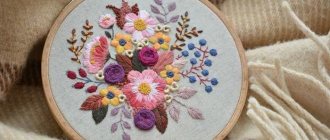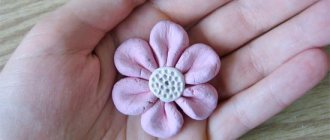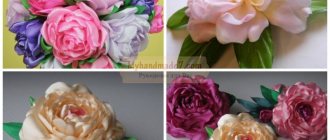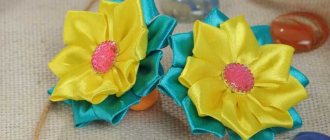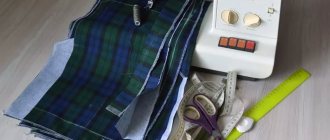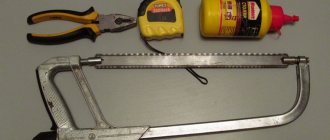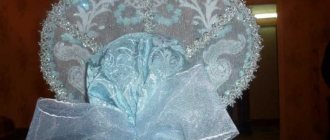Embroidery on jeans is in great demand among young people. This new fashion of the 21st century looks very fashionable, beautiful and elegant. The fashion industry has come a long way. On the catwalk we often see a variety of extraordinary clothes that the average person cannot afford. Recently, handmade decor has taken first place among fashionable outfits. Girls fell in love with denim trousers, which are easy to wear and have interesting new designs.
Ideas for satin stitch embroidery on jeans.
Decorate the trousers using beads and rhinestones.
Examples of how to embroider on the pockets of trousers and shorts, an option for beautiful decor.
Thread embroidery – “Flowers”
The most common type of embroidery is flowers. What materials are needed for thread embroidery on jeans.
- Naturally, first of all you need the jeans themselves;
- in this matter you cannot do without needles, always sharp ones;
- hoop;
- threads, preferably floss, but in general any multi-colored ones are possible;
- sharp scissors;
- honey or a marker that can be washed off;
- transfer paper;
- non-woven fabric or canvas overlay.
Work process
Now let's look at each action step by step:
- Using chalk or a washable marker, apply the sketch you like to the place you have chosen for the drawing.
- Work must begin directly from the very top of the petal.
- Embroider all the flowers that are in your drawing.
- It is best to make the flower stem with a chain stitch, and the petals and leaves with a satin stitch.
This way you can decorate not only your bored jeans, but also your child’s things.
Decorate with lace
How to decorate jeans with lace? Lace is always gentle and feminine. Things with lace speak about your individuality and subtle taste. Lace never goes out of fashion, making an applique or a lace patch is all we need. The lace can be narrow or wide, color: white, black, flesh-colored. If you know how to crochet, that's great. Then you can knit the motif, or tie the bottom of the jeans with your own hands - this is very popular in the summer season. You can also make a lace lapel at the bottom.
Embroidery with beads
On a note!
Beaded embroidery on jeans is not only a beautiful decoration, but can also create a more voluminous design.
Step-by-step instruction:
- First you need to decide on the scheme that you will use for work.
- Next comes choosing the place where your pattern will appear.
- Carefully secure the pattern by finishing the edges of the embroidery on the jeans with a regular stitch.
- Proceed directly to the bead embroidery itself.
How to install an invisible patch
For an inconspicuous patch, select a fabric similar to the material of the trousers. The damage site is cut out in the shape of an oval or square. The patch follows the shape of the cut out part, but is larger by the amount of allowance. The direction of the warp thread on the trouser leg and the patch must match, so the result of the repair will be barely noticeable.
The blank is placed under the trouser part and adjusted with a straight stitch. The allowance is cut off by 0.3 cm and secured with a small zigzag. The closer the threads of the last line are in color to the material of the trousers, the more invisible the work will be.
Satin embroidery
If you have a good imagination and a little skill, then even with the help of regular satin stitch embroidery, you can create a work of art on jeans.
- First, you need to draw a pattern with chalk or a dry-erase marker.
- Next, we fill in all the necessary elements with satin stitch using threads of the desired color.
- Pour until the design is completely filled.
- We secure the thread thoroughly and examine our work.
- The last stage is trying on jeans with embroidery.
How to sew decorative elements
Leisure clothing and children's jeans are often decorated with decorative stripes and embroidery. Damage to the fabric can also be covered with a colored patch; clothing design will only benefit from this.
Decorative elements can be sewn in different ways:
- by hand with neat small stitches;
- colored zigzag and straight stitch along the perimeter of the patch.
It will be good if the decorative stripes are matched in style with the existing ones. On trousers without stripes, you will have to create the design yourself. Some of the stripes will hide defects, while some will be sewn on only for decoration.
Holes in jeans
On a note!
Another way to not only give new life to your item is holes. Ripped jeans are the trend these days. They are a must have in any girl's wardrobe.
Step-by-step instruction
- Using a regular grater with convex edges, rub your jeans horizontally.
- Carefully pull out the threads with a crochet hook.
- Continue rubbing with the seam ripper in a horizontal direction until holes appear on the jeans.
How to quickly close torn areas if there is no time
The process of darning jeans or sewing on a patch takes a long time or requires the use of a sewing machine. If you don’t have the time and the necessary equipment, you can decorate the damaged area on your knee with a sticker made of Swarovski crystals.
There are ready-made drawings on sale; they are the easiest to work with. It is enough to choose a drawing of a suitable theme and size. You can buy rhinestones coated with adhesive and make a design out of them yourself.
All work takes place in several steps:
- The damaged area is cut out. A patch of similar fabric is placed underneath.
- The edges of the lower part are glued with adhesive web or sewn around the perimeter.
- A pattern of rhinestones is laid out on the area to be covered. Cover with a piece of fabric and fix the temperature of the iron.
- The trousers are turned inside out and the area to be treated is carefully ironed from the wrong side.
Thermal patches are a kind of lifesaver when you don’t have enough time for lengthy repairs. The procedure for working with them is the same as with a pattern made of rhinestones. The quality of the repair depends on the mode of the iron and the time of its exposure. You can check the quality of gluing after the area being ironed has completely cooled.
Registration through services
- All articles
- Handmade
- Denim - do-it-yourself alteration of denim clothes
Inspired by the article about patches, I was looking for interesting ways to decorate old jeans (and I had a huge amount of them), and came across master classes from the Spanish youth brand Desigual.
This is where the flight of fancy can be seen! On their official website there is a collection of Exotic Jeans, in which each pair of jeans is decorated by hand. This collection was inspired by the markets of India, where the senses explode with a mixture of spices, colors and textures. “Turmeric, coriander and cardamom breathe in every stitch...(c) Desigual
1. So, to create these jeans you will need:
- thread and needle (or sewing machine);
- scraps of lace and fabric with a houndstooth pattern;
- sandpaper or fine grater.
We take regular classic jeans without any decoration.
Using a grater or sandpaper, make abrasions on the legs in the places where you want to create a ragged effect. You should rub vertically (with the jeans straight), in short jerks, pressing the grater tightly against the jeans. Thus, the top layer of denim will tear, and the threads of the bottom layer will fluff up enough.
Then glue the pieces of lace and black and white fabric into a houndstooth pattern using textile glue. For greater strength, you can also sew these patches to the jeans, leaving 1 cm from the edges.
You can also add a hem from a second pair of jeans by stitching it along the bottom - this way you get the effect of a fashionable double hem.
2. To create these jeans you will need:
- thread and needle (or sewing machine);
- decorative braid or ribbon (sold on Amazon);
— decorative stripes (can also be purchased on Amazon);
As in the first case, we take ordinary jeans without any decoration (this pair had small abrasions).
We attach a decorative braid or ribbon of your choice to the belt at the waist (here are several types of braid in the oriental style).
Then use textile glue to glue the decorative stripes to the jeans. Using gold thread, make stitches on the legs in the style of Japanese sashiko embroidery (even stitches with the needle forward).
3. Well, the third alteration is a denim jacket. You will need:
- thread and needle (or sewing machine);
- decorative braid or ribbon;
- fabric marker;
- sleeves from other clothes.
We take a classic denim jacket without any decoration. Cut off the sleeves of the jacket, leaving 2 cm on each edge. Unravel the threads using tweezers and a pin to create a fringe, as in the photo. You will get a vest.
Using textile glue, glue pieces of different decorative braid onto the vest. You can make a drawing or embroidery on the back of the vest. Replace buttons with decorative buttons.
Finally, take the sleeves from an old sweater, sweatshirt, cardigan, etc. and sew them to the vest by hand or using a sewing machine.
In general, on the official website of Desigual you can see a lot of interesting things, decorated in the same way as described above. These are vests, jeans, jackets and even bags and shoes. So I recommend that needlewomen who have suitable material (denim) take a look there.
Pearl
Pearls are a decoration that is always associated with femininity and tenderness. In recent years, it has often been used to decorate clothing: sweaters, jackets, dresses and jeans.
White, cream and black go very well with different shades of blue, so choosing colors will be easy. Here the decoration method is similar to beads. The main thing is not to overdo it.
You can “play” with different sizes of pearls, and also think about combinations with other types of jewelry: light lace to add airiness to the look, or with studs for an interesting contrast.
Rules for caring for decorated models
Clothes decorated with embroidery or rhinestones or beads require more careful care:
- Jeans with rhinestones or adhesive appliqués should not be dry cleaned, otherwise the shiny decor will quickly peel off;
- It is better to wash things by hand so that the rhinestones do not come off. If you cannot do without machine washing, then the jeans must be turned inside out. Recommended water temperature is 30˚ C. It is better to use liquid detergent and do not turn on the spin mode;
- Decorated jeans should be ironed from the inside out or through a thin, damp cloth. Although wearing slightly wrinkled jeans has also become a fashion trend.
Thanks to a creative approach, it's easy to give old or new jeans a stylish, unmatched look. And then there will be a desire to wear such clothes with pleasure again.
Decoration options
High-quality handmade work can turn any jeans into a fashion product. Moreover, you can make do with improvised materials and tools: threads, buttons, scissors. More sophisticated appliqués, rhinestones, and silk embroidery will add glamor to your jeans.
When decorating light-colored jeans (white, blue), you need to make sure that the decor (embroidery, appliqué) does not fade. To do this, the product or threads are soaked in hot water (40-50˚ C). After 25-30 minutes they are wrung out through a white cloth. The decor can be applied if there are no colored stains/stains left.
It is not advisable to decorate jeans in the knee area - this is where the material wrinkles and deforms the most.
Rhinestones
The easiest way to add a glamorous shine to clothes is with the help of beads or rhinestones. Ornate lines and small patterns decorate the entire front surface of the trousers or individual areas.
To fix the rhinestones, strong and reliable glue is used. Difficulties can only arise when gluing the first rhinestones. A little time and perseverance - and it will be easy and simple to lay out an original pattern or ornament with rhinestones. If you first sketch out the lines of the pattern on the material, the process will take little time.
Small rhinestones are great for decorating the top line of pockets (front and back), and belts. When gluing rhinestones, it is important to maintain a sense of proportion.
Lace
Lace fabric is an original decor for both ripped and regular jeans. For relaxation, light jeans are suitable, the back pockets of which are decorated with white lace (completely transparent or denser). The lace fabric is cut out into the desired shape and simply glued to the pocket (using a lace web).
A creative option for a bold fashionista is jeans with lace stripes. Moreover, inserts with curly contours look interesting.
There is a lot of room for imagination - different combinations of shades. Dark gray jeans with black lace look intriguing. On vacation, white or blue jeans with white lace look fresh and easy. A combination of white jeans and pale pink or blue lace will be no less impressive.
Application
Such decor has long lost its original purpose - to mask holes in clothes. Today, appliqués add style and creativity to ordinary items. It’s easy to sew or glue “patches” made of leather or fabric onto thick jeans. It is especially beautiful and relevant to decorate summer jeans with knitted elements.
It’s easy to choose motives for appliqués - you can come up with your own, cut out a patterned part of the fabric or purchase a ready-made one. A non-standard solution - applique as an element of the pattern. In this case, several materials are combined - rhinestones, embroidery, drawings.
The most common applications are for children. As a rule, the reverse side of such products is adhesive and it is enough to attach the picture to the jeans and iron it with an iron. Most often, children's jeans are decorated with this method.
Transparent tulle appliques look delicate on light jeans. To disguise the stitching, the part is sewn with hidden stitches.
Coloring
Denim is a great material for experimenting with dyeing at home. Moreover, you can transform the shade of both new trousers and shabby ones. If the jeans have simply lost their “marketable appearance”, you can restore the shade. A primitive way is to wash old and new trousers in a machine at 40˚ C. In order for the paint to better saturate the fabric, the washing process is stopped for 2-2.5 hours without removing the items from the water. It is better to rinse clothes in water acidified with vinegar.
Thanks to more complex manipulations, you can get a stylish, trendy item. Jeans are painted with multi-colored dyes in random order. Stages of work:
- cover a flat surface with film and lay the jeans on it;
- If bleach is dripped onto the fabric, light stains appear. If you want a more bleached shade, apply bleach again;
- Acrylic paints (colors of your choice) are carefully applied to the fabric in the area of the stains using a sponge;
- Using a toothbrush and acrylic paints, you can easily paint many small colored dots on your trousers.
To make the clothes look organic, the colors are applied along the entire front side of the jeans, slightly touching the side seams.
Rhinestones
A fashionable and vibrant trend that can decorate various types of clothing. Everything is simple here!
Buy jars with rhinestones and start creating: you can make an extensive pattern, draw a couple of ornate lines, or lay out just a couple of “spots”-accents, for example, on a pocket or on a lapel.
It is better to use hot-fix rhinestones rather than attaching them with glue. In the first case, the glitter will stick much stronger.
